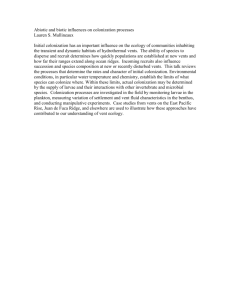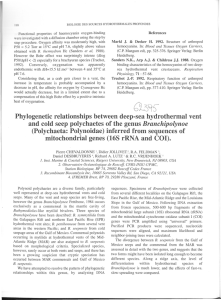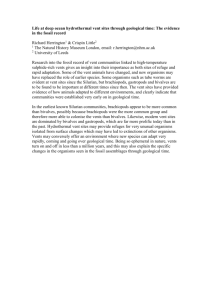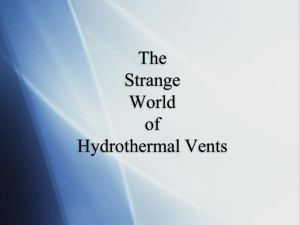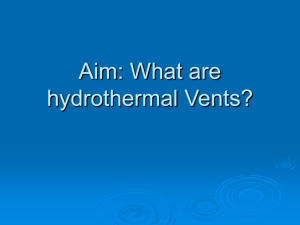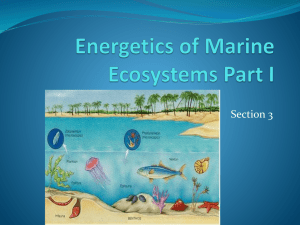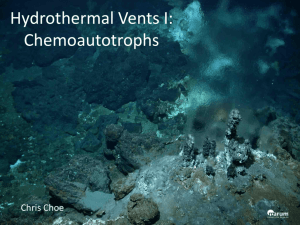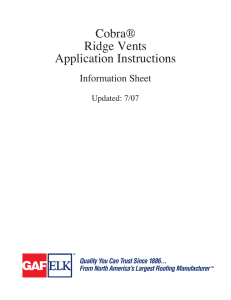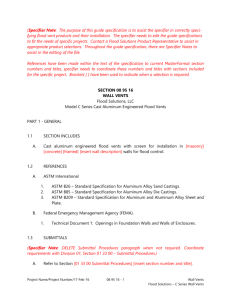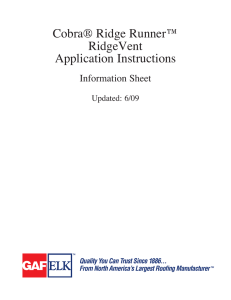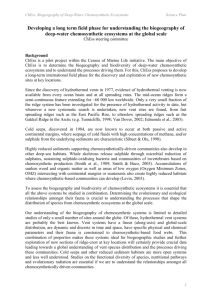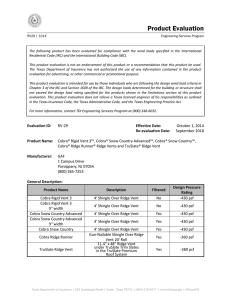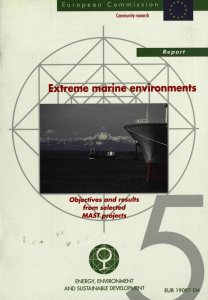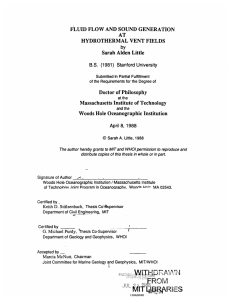Spatial scaling of deep-sea hydrothermal vent food
advertisement
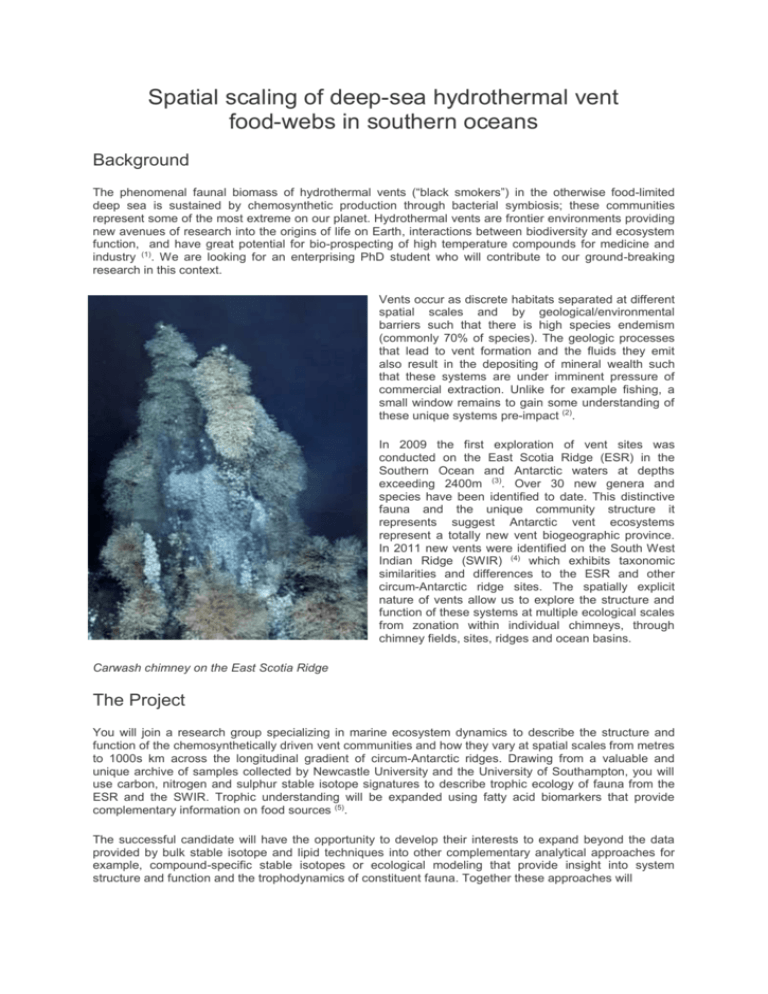
Spatial scaling of deep-sea hydrothermal vent food-webs in southern oceans Background The phenomenal faunal biomass of hydrothermal vents (“black smokers”) in the otherwise food-limited deep sea is sustained by chemosynthetic production through bacterial symbiosis; these communities represent some of the most extreme on our planet. Hydrothermal vents are frontier environments providing new avenues of research into the origins of life on Earth, interactions between biodiversity and ecosystem function, and have great potential for bio-prospecting of high temperature compounds for medicine and industry (1). We are looking for an enterprising PhD student who will contribute to our ground-breaking research in this context. Vents occur as discrete habitats separated at different spatial scales and by geological/environmental barriers such that there is high species endemism (commonly 70% of species). The geologic processes that lead to vent formation and the fluids they emit also result in the depositing of mineral wealth such that these systems are under imminent pressure of commercial extraction. Unlike for example fishing, a small window remains to gain some understanding of these unique systems pre-impact (2). In 2009 the first exploration of vent sites was conducted on the East Scotia Ridge (ESR) in the Southern Ocean and Antarctic waters at depths exceeding 2400m (3). Over 30 new genera and species have been identified to date. This distinctive fauna and the unique community structure it represents suggest Antarctic vent ecosystems represent a totally new vent biogeographic province. In 2011 new vents were identified on the South West Indian Ridge (SWIR) (4) which exhibits taxonomic similarities and differences to the ESR and other circum-Antarctic ridge sites. The spatially explicit nature of vents allow us to explore the structure and function of these systems at multiple ecological scales from zonation within individual chimneys, through chimney fields, sites, ridges and ocean basins. Carwash chimney on the East Scotia Ridge The Project You will join a research group specializing in marine ecosystem dynamics to describe the structure and function of the chemosynthetically driven vent communities and how they vary at spatial scales from metres to 1000s km across the longitudinal gradient of circum-Antarctic ridges. Drawing from a valuable and unique archive of samples collected by Newcastle University and the University of Southampton, you will use carbon, nitrogen and sulphur stable isotope signatures to describe trophic ecology of fauna from the ESR and the SWIR. Trophic understanding will be expanded using fatty acid biomarkers that provide complementary information on food sources (5). The successful candidate will have the opportunity to develop their interests to expand beyond the data provided by bulk stable isotope and lipid techniques into other complementary analytical approaches for example, compound-specific stable isotopes or ecological modeling that provide insight into system structure and function and the trophodynamics of constituent fauna. Together these approaches will 1) Describe How trophic functions vary within chimneys on the ESR 2) Examine to what extent vent fluid chemistry determines this trophodynamics 3) Assess how trophic roles of species or congenerics vary across ecological scales from among sites on the ESR to the Indian Ocean circum-Antarctic ridges 4) Develop function and trait based analyses that describe general structuring rules for vent systems and describe functional equivalence (or lack thereof) among vet sites The Supervisory Team You will be supervised by Prof. Nick Polunin, Dr Ben Wigham and Dr Chris Sweeting (School of Marine Science & Technology). Prof. Polunin leads the Marine Ecosystems and Governance research group at Newcastle (http://www.ncl.ac.uk/marine/research/science/ecology/index.htm) and is a marine macroecologist who has pioneered stable isotope approaches to marine food webs, working extensively with Dr Sweeting. Dr Wigham is a deep sea specialist with research interests in the physiology of deep sea species, energy flow in deep sea and ridge systems and in reproductive and larval ecology and system connectivity. This work will be conducted within a wider collaboration of ongoing deep sea research including Dr Jon Copley (University of Southampton; chemosynthetic ecosystems), Dr David Pond (SAMS, Oban; lipids) and Dr Will Reid (Biology, Newcastle University; vent ecology, ecological modelling) Informal enquires: Dr Chris Sweeting (christopher.sweeting@ncl.ac.uk, 0191 222 6658). (1) Arico S, Salipin C (2005) Bioprospecting of Genetic Resources in the Deep Seabed: Scientific, Legal and Policy Aspects. United Nations University (http://www.ias.unu.edu/binaries2/DeepSeabed.pdf) (2) International Seabed Authority (2011) Environmental management of deep-sea chemosynthetic ecosystems: justification of and considerations for a spatially-based approach (Technical study; no. 9), 79pp, ISBN 978-976-95268-9-1 (3) Rogers, A.D., et al. (2012) The discovery of new deep-sea hydrothermal vent communities in the Southern Ocean and implications for biogeography, PloS Biology, 10(1) e1001234. doi: 10.1371/journal.pbio.1001234. (4) Qiu J (2011) Indian Ocean vents challenge ridge theory 'Football fields' of vents among the largest known.Nature News (20 December 2011) | doi:10.1038/nature.2011.9689 (5) Stevens CJ et al. (2008). Ontogenetic shifts in the trophic ecology of two alvinocaridid shrimp species at hydrothermal vents on the Mariana Arc, western Pacific Ocean. Marine Ecology Progress Series. 356: 225-237.
